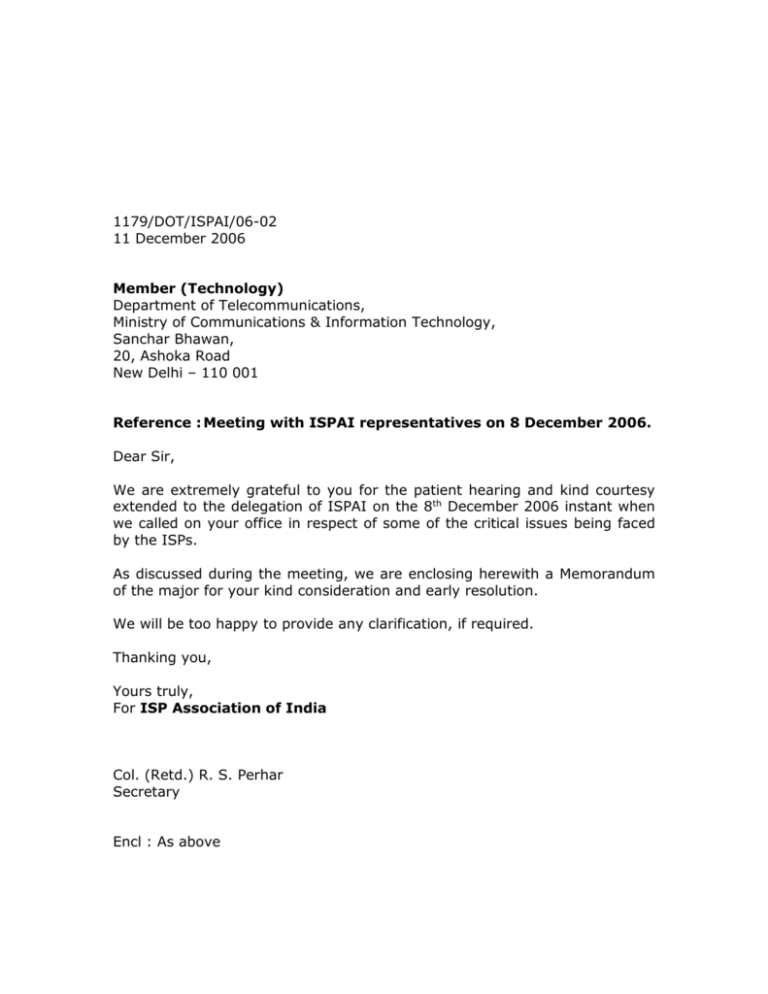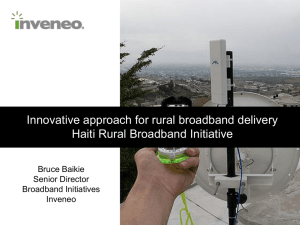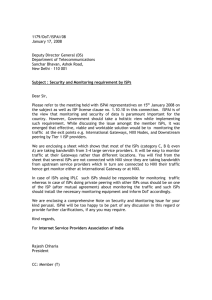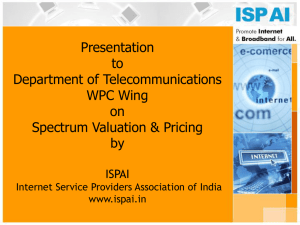Ref : SIL/DTS/3201 - Internet Service Providers Association of India
advertisement

1179/DOT/ISPAI/06-02 11 December 2006 Member (Technology) Department of Telecommunications, Ministry of Communications & Information Technology, Sanchar Bhawan, 20, Ashoka Road New Delhi – 110 001 Reference : Meeting with ISPAI representatives on 8 December 2006. Dear Sir, We are extremely grateful to you for the patient hearing and kind courtesy extended to the delegation of ISPAI on the 8th December 2006 instant when we called on your office in respect of some of the critical issues being faced by the ISPs. As discussed during the meeting, we are enclosing herewith a Memorandum of the major for your kind consideration and early resolution. We will be too happy to provide any clarification, if required. Thanking you, Yours truly, For ISP Association of India Col. (Retd.) R. S. Perhar Secretary Encl : As above CRITICAL ISSUES BEING FACED BY ISPS WIRELESS RELATED ISSUES Retrospective charges on WPC agreements / operating license WPC vide letter no. L-14035/21/04-LR/3139 dated 21st April 2006 intimated to the ISPs that spectrum charges will be applicable to be paid from the date of issue of the Decision Letter. Although it is not mentioned in the above letter but our members are being informed that unless and until they pay spectrum charges retrospectively from April 2004 onwards for all frequency assignments made, the applications with regard to new licenses/ frequency assignments/ imports etc will be kept pending. ISPAI suggests : The Government is at full liberty to change terms of license, however, to ask for payment with retrospective effect is not justified and against the laws of natural justice. No where the above quoted letter mentions payment from retrospective date. Keeping this in view, clearance of applications on unrelated issues e.g. import licenses etc should not be kept pending for reasons of existing disputes. The applications should be cleared expeditiously to allow movement of business. We also suggest that Spectrum charges should be charged from a date at-least six months from the date of issue of the Decsion Letter. This will allow ISPs to obtain import license, import equipment, test it, apply for SACFA, obtain operating license and install equipment. In case the SACFA process is shortened in time this period of six months can also be suitably reduced. Charges to be levied on BTS on City/ Location Basis To provide QOS, obtain LOS and make efficient use of the spectrum allocated ISPs have to install a number of BTS in a local area. As per present regulations the ISP’s have to pay license fee for every additional BTS within the service area even in two adjacent buildings and using the same spot frequency therby making rollout extremely expensive in opex.. 2 ISPAI suggests : License fee should be levied as presently applicable for first BTS in each on City / Town instead of per BTS the additional BTS be charged nil license fees or a nominal amount of say Rs 1000 per annum. This will help in effective use of spectrum as the frequency being used is the same, affordable pricing to the public at large and quick roll out of Broadband services across the country. De-licensing of 5.7GHz Band ISPAI will welcome the govt’s move to de-license the 5.7 GHz band, Allocation of 2.5, 3.3 and 3.5 Band With regard to the allocation of the above bands to ISP’s for rolling out WIMAX services in both urban and rural areas and also keeping in view the recommendations of TRAI of 27 Sept. ISPAI has already sent its comments vide our letter no 1262/WPC/ISPAI/06/01 dated December 4, 2006 Copy attached for ready reference. We wish to further state that though we have recommended that the allocation of these bands should continue as hitherto- fore and that auction process keeping in view the differences in licensing conditions, services provided, financial worth etc of ISP’s vis-a- vis telcos is not justified. We also state that when the expert committee is considering the TRAI recommendations regarding vacation / migration of 2.5 and 3.3 band then all ISP’s allocated this band and presently operating on it may be compensated to the extent of their investments and consequential losses as has been done for defence. We also request that the applications for allocation of the 3.3 Band which have been lying pending of ISP’s in some cases for over a year maybe expeditiously cleared. In case any under taking is required pending decision of the Govt on TRAI recommendations ,same can be communicated to the respective ISP’s. We request the DOT to let business continue by clearing the applications immediately. The ISP’s are under extreme financial burden awaiting clearances. 3 As suggested by your good offices we will request The Wireless Advisor, Chairman of the Expert Committee to allow us the opportunity to present our views on TRAI recommendations on ““Allocation and pricing of spectrum for 3G services and Broadband Wireless Access” to the committee .A request in this regard is being sent. LICENSING ISSUES ISPAI suggests that Government should take a holistic review of ISP license including Internet Telephony. Internet Telephony – Level playing field As per the guidelines for issue of permission to offer Internet Telephony Services “Only ISP licensees are permitted, within their service area, to offer such Internet Services. Subsequently, w.e.f. 1st January 2006 this service has also been included within the UASL license. Hence Internet Telephony service can be offered in India either by ISPs specifically permitted to do so (in a restricted manner) or by a UASL licensee un-restricted. Some foreign service providers like Net 2 Phone, Vonage, Dialpad, Impetus, Novanet, Euros, skype, yahoo, msn etc are providing Internet Telephony to the Corporate, Call Cenres, BPOs and people of India. People can visit websites and buy minutes by making payments through credit cards. Essentially, these vendors just buy minutes from companies like those mentioned or buy directly from the websites and then re-sell it locally to the corporate, call centres, BPOs etc. This causes loss of foreign exchange and license fees to the nation It is a matter of record that these service providers do not possess the requisite license as mandated by the Government of India for Indian ISPs, thus not only disturbing the level playing field for bona fide licensees, but also causing great loss of revenue to the government. These service providers don’t charge 12.24% Service Tax on the Internet Telephony minutes nor 6% AGR imposed by Govt. w.e.f. from 1 January 2006. It is also a serious security threat to the nation as these service providers do not come under any Indian regulatory/policy framework. It may not be possible to obtain any data pertaining to the use of Internet Telephony like CDRs etc from them. 4 ISPAI suggests Either 12.24% Service Tax and 6% AGR (proposed) should not be applicable on Indian ISPs offering Internet Telephony services or foreign service providers should be brought under the Indian licensing regime. DoT should put a notice on its websites as well as in the print media clearly indicating the names of operational ISPs with Internet Telephony Licenses so that ISPs can educate the users not to use the services of un-authorized service providers While issuing new OSP licenses DoT should take an undertaking from the call centres, BPO, KPO to mention the name of authorized service providers from which Bandwidth and Internet Telephony Minutes will be taken. DoT should ask OSP to provide copy of bill of Internet Telephony minutes at least once in 6 months to avoid use of illegal Internet Telephony Minutes. Clearance of ISPs / ITSP Licensees It has come to our notice that Department has kept pending ,for months, issue any new licenses for ISPs as well as licensees for provisioning of Internet Telephony by the existing ISPs. Number of potential investors and applicants including those with FDI proposals are awaiting license. This delay if allowed to carry on will result in investment moving into other countries, thereby directly effecting growth of Internet including Broadband in India. ISPAI suggests : Govt should encourage more and more companies to become ISPs so as to spread the use of broadband across the country and bridge the digital divide. The pending licensee may pleased be cleared expeditiously. DoT should fix up time frame for issuance of license, other clearance and status of pending applications should be made available in a transparent manner. Interconnection between ISPs and ITSPs Interconnection between ISPs and ISPs offering Internet Telephony should be allowed as all the upstream service providers hold the Internet Telephony licenses and ISP has to take bandwidth from them, therefore, there will an interconnection between them. 5 Steps need to be taken for proliferation of Broadband in the Country specially in remote and rural areas Hon’ble Minister has declared the year 2007 as Broadband year. Target set by Government in the Broadband Policy can be achieved and ISPs can play vital role in achieving the targets if the Government consider the following : ISPs role in remote/rural Broadband Penetration Local ISPs can help people in remote /rural areas by providing them training, guidance and maintain their computers/systems. It can help in creating new employment opportunities for the rural people by encouraging them to start their own business (cyber dhaba). Since local/ small ISPs are closer to the user and in a position to know their social and financial conditions better than multiple service providers can provide the best possible route to entrepreneurship to rural mass with a sense of fulfillment of a larger social goal. Why Broadband Network We must agree on certain key attributes and objectives to be used as the basic criteria for broadband to be classified as a ‘key infrastructure’ in the true sense. It would be appropriate to extend the Income Tax benefits under section 80 (I) (A) to ISPs and other licensees who are authorized to provide Internet and Broadband access. Support from USO Fund for Rural Broadband Support from the USO Fund must be provided for all new rollouts if the service offering inherently and necessarily includes broadband in the rural areas; limiting the same to voice telephony alone would mean higher dependence on subsidies and lesser local support from the community. This would significantly reduce the load on subsidies. While announcing Broadband Policy 2004, the government had said that “Broadband services can reach the urban and rural consumers only if services are offered at affordable and easy terms. Department of Telecommunications will work out a package in consultation with Ministry of Finance and related Departments as well as concerned service providers to achieve this.” 6 Rural Internet Telephony Internet Telephony in rural/remote areas can easily be bundled with Broadband connection. One PC with broadband connection with Internet Telephony at least to a Post Office, Panchayat and/or District Head Quarter . Rural mass can be benefited immensely by the bundle of services instead of plain Telephone. They can use it for talking to their relatives in towns/cities in a much lower rates. If a person sitting in Delhi or Mumbai can talk to a person in New York or LA for less than Rs. 2 a minutes why can’t we offer such facility to our own people with in India. It will be help in bridging the digital divide. Unified access providers will never offer unrestricted VoIP as it would compete with its core offering. Therefore, unrestricted VoIP should be allowed to ISPs. Then only UAS providers would compulsorily start this service to offer benefit to all using Internets and thus paving the way for popularizing IP based services. – thus enabling the incentives for Nexgen Networks and platform independent services to the customers. Infrastructure Sharing Roll out of Broadband, IPTV and Internet in the remote and rural area is possible if UASL and/or Basic Operators share their networks / resources with ISPs on a commercial terms and condition. It is learnt that BSNL copper is reach almost 20 km of every villages. Same can be shared with ISPs in reaching to the rural mass to connect them to the world. Wireless in the Last Mile/ Access Network Wireless is the best alternative for last mile connectivity. Government should facilitate ISPs use Wireless for last mile specially in rural/remote areas as it is an ideal solution for extending the access in rural areas. We must be open to cover all technologies not limited to GSM and CDMA but also Wi-max, VSAT and any other upcoming technology. Since the chances of harmful interference in rural areas are virtually remote, higher power output should be permitted; e.g. FCC in the US is considering up to 25 watt EIRP or BTS installed in the rural areas whereas the typical limits in the urban areas is just 4 watts. This would also enhance the cell size catchment area under coverage and thus decrease the total cost. As the same time, instead of roll out obligations, incentives should be given for investment in rural areas. Similarly to reduce the VSAT cost, we explore to reduce the Antenna size to .9 M *************************** 7 8








